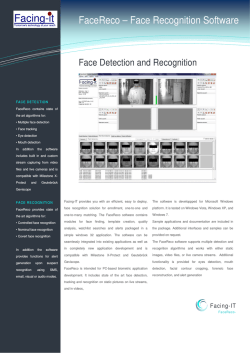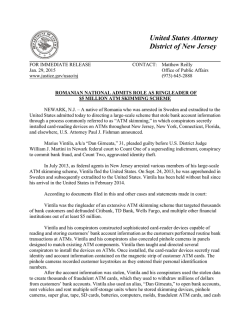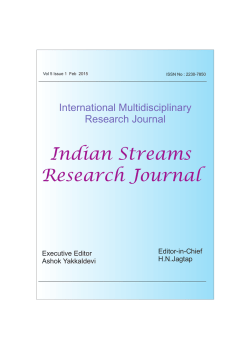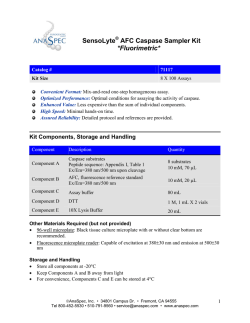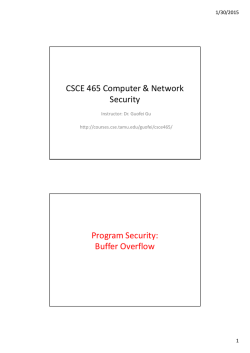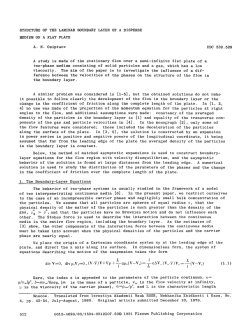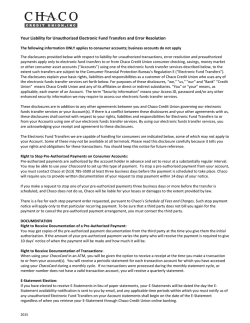
The MAPS control paradigm: using chaotic maps to
Published in: Broadband Communications- The future of telecommunications
Eds. Kühn P., and Ulrich R., Chapman and Hall, London, 1998, pp371-382
The MAPS control paradigm: using
chaotic maps to control telecoms
networks
L.G. Samuel, J.M. Pitts, R.J. Mondragón, D.K. Arrowsmith
Queen Mary and Westfield College
Mile End Road, London E1 4NS, United Kingdom, e-mail:
{L.Samuel, J.M.Pitts, R.J.Mondragon, D.K.Arrowsmith}
@qmw.ac.uk
Tel: +44-171-415-3756
Fax: +44-181-981-0259
Abstract
This paper proposes a new control method for telecommunications networks based
on chaotic dynamics. Self-similar behaviour has been observed in a variety of
services and networks. ATM is a unifying vehicle for transporting a wide range of
traffic streams, and hence is a focus for assessing the impact of self similarity on
networks. Chaotic maps have been used to model self-similar traffic. Using this
approach, we present results that show the sensitivity of the Hurst parameter to
the dynamical parameters. Conventional control techniques for ATM each address
only a single time scale, and hence are less effective as a result of self-similarity in
the traffic behaviour. We set out the MAPS control paradigm, using local control
techniques in coupled map lattices, which aims to effect control over the range of
relevant timescales.
Keywords
Self-similar traffic, ATM networks, chaotic map, chaotic control
1
INTRODUCTION
ATM is becoming the transport vehicle for a wide variety of traffic streams,
whether it is legacy traffic, LAN-LAN, Internet IP, multimedia, etc. ATM was
created as a unifying transport mechanism. The mechanism provides the means to
statistically multiplex variable and constant bit rate streams. One of the main
features of ATM is its statistical multiplexing gain (Saito, 1994). Statistical
multiplexing gain arrives out of multiplexing traffic streams where the sum of the
individual peak bandwidths is greater than the capacity of a given link (Chen,
1995). This is possible because the peaks in the individual traffic streams seldom
occur together. Therefore the statistical multiplexing effect relies on the condition
that enough sources are multiplexed and that they are not correlated (de Prycker,
1991). The analysis of such a gain has been attempted under the assumptions of
Poisson arrival processes and exponential distributed holding times (Saito, 1994).
The implication of this type of analysis is that such traffic streams when
aggregated tend to white Gaussian noise, i.e. the variation of the traffic would
eventually smooth out (see Figure.1 after Figure 4 in Leland 1994). However,
traffic measurements carried out in the late 1980’s and early 1990’s revealed that
whereas the correlations of the traffic were thought to decay exponentially fast
(Markovian in structure) the traffic measured in real networks possessed
correlation structures which decayed much slower than exponentially (Fowler,
1991). This type of traffic has become known as Long Range Dependent (LRD).
Why should this be a problem? The answer lies in the correlation structure of
the LRD traffic. Heuristically, one can view the individual traffic streams’
correlation as overhanging each other when aggregated, causing an increase in
the probability of the large aggregated bursts occurring. More importantly the
aggregated traffic streams do not tend to white Gaussian noise (for a
representation of these effects see Figure 1). In actual fact the aggregated traffic
process tends towards a second-order statistically self-similar process which
remains bursty over many time scales (Fowler, 1991). This feature of the traffic
poses problems for the traffic control schemes designed for ATM. In ATM
preventative congestion control is preferred over reactive congestion control
schemes. This is because the reactive control becomes inadequate in terms of
response times for the high bit rates used in ATM (Chen, 1995). The preventative
measures are concentrated in the connection admission control schemes (CAC)
used to make decisions on the acceptance of calls into the system. It now appears
that CAC cannot minimise the congestion within the network and increasing
buffer sizes also appear to have no effect (Leland, 1994). For this reason the time
has arrived to consider control schemes which are based on totally different
paradigms. In this paper we present such a paradigm based on chaotic dynamics.
The organisation of the paper is as follows: in section 2 we give a brief
introduction on the nature and effects of self-similar traffic; in section 3 we
outline how dynamical systems can be used to model teletraffic; and in section 4
we describe the principles of chaotic control.
Real Traffic
Markov Models
Figure 1 Real traffic trace against Markov model based trace for the same load.
(The picture is taken from figure 4 in Leland (1994), Reproduced with
permission).
2. THE IMPACT OF SELF-SIMILAR TRAFFIC
Fowler (1991) reported on studies conducted at the at the end of the 1980's and
early 1990's that packet traffic exhibited burstiness over a large number of time
scales. These bursts exist at every time scale, from milliseconds to days and they
look similar independently of the time scale, i.e. the traffic is self similar. One
characteristic of this self-similar traffic is that it is correlated at all time scales of
engineering interest, i.e. the traffic has long range dependence (LRD). The selfsimilarity and the LRD are quantified by the Hurst parameter H (½≤H<1). Large
values of H correspond to larger fluctuations on the burst size and stronger
correlations in the traffic. These large fluctuations manifest themselves as heavy
tailed distribution in the LRD traffic (Leland, 1994) and has been linked to the
probability of higher buffer occupancy (Norros, 1993). Practically this increased
probability has a drastic effect on the buffer occupancy since providing more
buffer space is not a solution to buffer saturation (Eramilli, 1996). Eventually the
buffer will fill up. The implication that an increasing value of H leads to higher
buffer state occupancy (Norros, 1993, Eramilli, 1996) and hence increased
probability of network congestion is much higher than if low valued H traffic was
present which is interesting from the point of developing a chaotic network
control since a small adjustments in H can drastically alter the buffer occupancy.
A natural question to ask would be: if CAC is conservative (in the sense of
admitting traffic to suit the bottle neck link) then why is it that cell loss still
occurs? The answer to this question lies in results presented by Willinger (1997).
They have shown that it is the aggregation of ON-OFF sources with ON and/or
OFF periods which are long range dependent that causes the self-similarity
present in the networks. It is the self-similarity and the LRD of the aggregated
traffic which is perceived as the future cause of network congestion (Leland 1994,
Fowler, 1991, Erramilli 1996). A first step in finding solutions to the problems
caused by self-similar traffic was research on models which adequately capture the
variability seen in real traffic. Conventional stochastic traffic models, based in
Markovian traffic theory, describe real traffic only over a single timescale. They
do not have LRD (see Figure 1). There exist alternative stochastic traffic models
known as Fractional Brownian Motion (FBM) models (Mandelbrot, 1968, Norros,
1993) which describe all the traffic characteristics of real traffic, the selfsimilarity and LRD. Alternatively, there exist models based on chaotic maps
which reproduce the properties of real traffic (Eramilli 1994a, Samuel, 1997b).
The need for the new models was so that the impact of self-similar behaviour
could be assessed against current and proposed provisioning practices for ATM
networks. Broadly, this research has taken the form of assessing the impact on the
buffers due to the self-similar traffic. The motivation for this research could be
said to be an attempt to reconcile the control of this type of traffic into some
queuing theoretic approach, which can then be used in "traditional ways" in order
to solve network provisioning and CAC (in ATM terms) problems that arise. In
the following paragraphs these approaches will be briefly outlined.
Certain approaches have been traffic class specific. For example traffic classes
such as VBRRT and CBRRT are very delay sensitive and have used control
paradigms based on buffer partitioning (Schormans, 1997) and priority scheduling
(Schormans, 1993) to solve the congestion. That is to say, the play-out rate of the
occupied portion of the buffer will be sufficiently fast enough as to make the
Markovian model estimation of the resource requirement conservative enough to
be useful.
One approach which one would have naturally thought that would have at least
reduced the impact of self-similar traffic on the network would have been traffic
shaping. One would have thought that spreading the burstiness of the individual
traffic sources would have altered the characteristics of the traffic sufficiently to
the point where individual traffic streams do not become a problem. Unfortunately
this is not the case (Leland, 1994). Work undertaken recently by Molonár (1997)
shows that shaping will not alter greatly the self-similarity present in the traffic. A
robust indication of this could be implied for the work of Eramilli (1996) where
experiments on reshuffled LRD data were undertaken. Essentially the entire order
of a data stream had to be shuffled randomly before the LRD nature in the stream
was lost. If all the LRD streams are shaped then all that is achieved is an
extension over the period over which the self similar traffic is present. This is
because shaping still preserves the order of the data.
Another approach had been to accept Markovian models as adequate and use
large deviation techniques to asses the impact of the rare event "large bursts" on a
queueing system. Here, large deviation theory is used to calculate the probability
of buffer overflow. This information is then used to provision the network/accept
calls accordingly. This too has led to the formulation of CAC algorithms based on
this principle (Duffield, 1995).
Naturally there have been approaches which combine FBM modelling and large
deviations theory in order to arrive at some qualitative assessment of the effects
self-similar traffic has on network buffering systems. These approaches have led
to the notion of cross-over effects when self-similar streams are multiplexed
together (Krishnan, 1996 and Fan, 1997). This effect describes an increase in the
multiplexing gain in the buffering system when streams of self-similar traffic are
multiplexed. However, once beyond the cross-over point the self-similar traffic
streams once again are detrimental to the network. The point in this approach is
however, that Markovian models (those with self-similarity parameter H=0.5)
provide good (conservative) estimates for the buffer sizes required by the system
in order to cope with the self-similar traffic streams.
Having summarised very briefly the traditional (current) control methods we
now look comparatively at the way in which control affects common areas where
chaotic control could be applied. The control of network traffic could be viewed
as:
1. Call level control - permits the traffic onto the network provided that there are
enough resources on the requested path which permit the incoming traffic to
propagate across the network with out causing congestion at the cell level.
2. Cell level control - allocates resources in the network (such as buffer space) in
order to accommodate the call in terms of cells or allow some traffic loss
according to some pre-agreed cell loss rate.
Both (1) and (2) have traditionally been handled on entry onto the network via
CAC algorithms. Additionally (2) can be approached via the design/dimensioning
of the switches and cell level control methods such as UPC. In MAPS control, call
level control is termed "order". This is the selection of call or burst based on a
weighted decision derived form the dynamics of the system (network). Cell level
control is termed "procession" and is the effect of the control of the dynamical
system which permits the transfer of the data between source and sink.
3. DYNAMICAL SYSTEMS APPROACH TO TELETRAFFIC
An ON/OFF traffic source can be modelled using the family of one dimensional
chaotic maps (Erramilli, 1994a, Erramilli, 1994b, Pruthi 1995a)
m
m
0 < xn ≤ d
F ( x ) = ε1 + xn + xn 1 (1 − ε1 − d ) d 1 ,
xn+1 = F ( xn ) = 1 n
m2
m2
F
(
x
)
=
ε
+
x
+
(
1
−
x
)
(
ε
−
d
)
1
−
d
,
( ) d < xn < 1
2
n
n
2
2 n
(1)
with parameters m1 , m2 ∈ (3 / 2,2) , ε 1 , ε 2 << 1 and 0 < d < 1 . The ON-OFF
traffic source is simulated by the associated indicator random variable (see Figure
2)
0,
yn ( xn ) =
1,
0 < xn ≤ d ,
d < xn ≤ 1,
passive state
.
a packet / cell is emitted (active state)
OFF
(2)
ON
1
ε2
F 1 (x)
x n+1
F 2 (x)
ε1
0
xn
d
1
Figure 2 Chaotic Intermittency map showing parameters d, ε1 and ε2 and curve
functions F1(x) and F2(x) (m1 and m2 describe the degree of polynomial for F1(x)
and F2(x) respectively).
In common with measured traffic, the traffic simulated by these maps has a noninteger fractal dimension (½≤H<1), long range dependence (LRD) on the
correlation and, if the outputs of several maps are aggregated, the simulated traffic
tends to FBM. For a summary of the different map interpretations as a source
model the interested reader is referred to the following references (Eramilli,1994a
and 1994b, Pruthi, 1995b, Samuel, 1997a and1997b).
Traffic with different characteristics is labelled by the parameters of the maps.
However, from a control point of view it is better to study the family of maps
rather than any individual member of the family. To this end the Bernoulli shift
map (which models Poisson-like behaviour, m1=m2=1), the single intermittency
map (which models traffic with LRD in either ON or OFF state, m1=1, m2>3/2 or
m1>3/2, m2=1) and the double intermittency map (which models traffic with long
range dependence in both ON and OFF states m1>3/2, m2>3/2) are all considered
members of the same family. These different traffic models are consistent with the
reported characteristics of ON-OFF sources by Willinger (1997).
As a first stage in developing a chaotic control for telecommunication networks
we have studied how H changes with the map parameters. A decision to alter H
based on the adjustment of these parameters can be interpreted as the controlling
action. For example an alteration in the value of ε imposes an upper cut-off on the
correlation, alteration in d changes the mean traffic load and changes in m1 and
m2 changes the sojourn time of the ON and OFF states, i.e. the LRD of the traffic
and its H value. Figure 3 shows two examples of the dependence of H with the
map parameters.
H
H
0.9
1
0.8
0.8
0.7
2
0.6
1.8
1.6
0.4
0.5
1.4
m1
0.6
2.0
1.2
1
1.00E-06
1.00E-05
1.00E-04
1
1.00E-09
0.4
0
0.2
m1
ε
(a)
0
2.0
1.5
m2
1.5
(b)
Figure 3 The dependence of the Hurst parameter on (a) m1 and ε1, and (b) m1 and
m2. All other parameters are fixed.
Figure 3(a) shows that, for a single intermittency map, as ε1 increases, the value
of H tends to 0.5 and the long range dependence disappears. Figure 3(b) shows
that, for a double intermittency map, the value of H depends on both m1 and m2.
These results show Eramilli’s conjecture (Eramilli, 1995, conjecture 3) that H is a
function only of m1 to be false.
As all sources can be modelled by a map, the next stage is to model the
aggregate traffic produced by the individual source maps with a single
“equivalent” map which preserves the traffic load and H. The parameterisation of
this “equivalent” map is reported in Samuel (1997a and 1997b).
4. THE MAPS CONTROL PARADIGM
In the section 3 we have mention how chaotic maps can be used to provide
aggregate models for self-similar traffic. We considered the case of aggregation at
a single node (Samuel, 1997a). A natural extension of nodal models is to couple
them together to form networks and then attempt to model and control the
characteristics of these networks. In such a model the nodes would be the
switching sites and the couplings between the nodes would represent the links
between the switching sites. The simplest mathematical models which resemble
such a construction are Coupled Map Lattices (CML) where a dynamical system
at each node will produce the local traffic input. Coupling will be provided by
external input from neighbouring nodes due to the queueing (aggregation) and
switching. This is shown schematically in Figure 4.
Map SWITCH
(NODE)
+
Map IN
Traffic in
+
Map OUT
Switch
Coupling
Traffic
Input aggregation
Traffic out
Output aggregation
+
Traffic in
Traffic out
Figure 4 Lattice interpretation of a telecommunications network.
Investigations have been made into regular lattice structures where coupling
exists between nodal sites. An important property has been the discovery that
global control across all nodes can be obtained via local control at each node
(Mondragon, 1997a and 1997b, Arrowsmith, 1996, Ott, 1990).
In these investigations the dynamical behaviour of each nodal site is modelled
by a chaotic map and the coupling to the neighbouring nodes imparts
perturbations into the orbits of the dynamical system containing the node. Since
the chaotic map's orbit possesses the property that any orbit will approach
arbitrarily closely every point of the plane described by the chaotic map, then at
some point the orbit must take it near to a desired control state. A small feedback
control applied at the target point in the orbit places the dynamics of the node into
a required state, since the same structure occurs at all nodes. Experimental
evidence shows that if desired control state is prescribed for all nodes then
eventually the lattice becomes controllable.
However, it is possible for
neighbouring dynamical behaviour to kick a node out of equilibrium via the
coupling and so "occasional feedback control" is introduced where the feedback
control is activated within the control region around the desired equilibrium for
only part of the allowable time, (Mondragon 1997a).
The outline given in section 3, see (Samuel, 1997a) describes how each node
site of the lattice structure can be modelled by a controlling map. The individual
traffic streams entering a node can be modelled by chaotic maps and in certain
models the maps can be aggregated into a single map which describes the
behaviour of the traffic at the node. The next step is to provide on-line
information on the Hurst parameter; this is necessary to enable the construction of
an active dynamic control environment.
We propose a control scheme that actively manipulates the value of H. Our
intended approach is based in manipulating H via the mean, peakedness and LRD
of the traffic stream characteristics via with a local control strategy. The
"philosophy" is not to destroy the chaotic behaviour of the traffic but instead to
use its variability as a method of control. Chaotic systems are everywhere unstable
and thus a small change in the system at any instant produces a large change at
later times (this is known as "sensitive dependence on initial conditions" or, more
colloquially, as "the butterfly effect") giving the controller "agility" to changes in
the traffic over many timescales. Moreover as was noted in the previous section,
successful control of coupled chaotic systems can be instigated with local control
of each system. The implication of this to networks should be significant, since it
suggests that for relatively small control actions applied locally the
congestion/buffer occupancy on local and remote switches (relative to the control
site) should be reduced. It is envisaged that the use of ATM mechanisms such as
ABR via a chaotically initiated control sequence would provide a mechanism for
the reduction of H and subsequent control of congestion.
We are proposing two different mechanisms to control traffic that is already in
the network. The first mechanism seeks to reduce the variability of the traffic in a
specific channel. This can be done by "careful" introduction of empty cells. The
control mechanism would modify but not destroy the highly variable behaviour of
the traffic. We conjecture that, individually, each of these controlled channels
would change very little but that these changes would have a larger effect when
the traffic is aggregated in the queue.
The second method is based in a random selector of calls in a node. The random
selector would choose which call to admit by weighting dynamically the statistics
of the traffic variability. The selector, modelled by a chaotic map, would assign
larger probabilities to some channels than others but all the channels would have
positive probabilities to be served. The first control technique is termed
"Procession" and the second "Order". Conceptual views of the proposed chaotic
control regime can be found in Figure 5.
Procession
Link Capacity
ABR CALLS
Synchronise through CML techniques
a calls procession across the network
Band Width
Avail. Band Width
Order
Chaotically Control the
order in which the calls
are selected
VBR traffic
ti
Time
tj
Figure 5 Conceptual view of chaotic network control as applied to ABR.
These two methods of control will be developed using chaotic maps as models of
self-similar traffic because it is known that they have the correct characteristics
and, moreover, that they can model high traffic rates efficiently (Samuel, 1997a
and 1997b).
5. CONCLUSION
In this paper we have discussed the problems presented by self-similarity in traffic
flow and summarised current views on resolving the problem of self-similar traffic
within ATM networks. The weakness of conventional approaches lies in their
addressing control over single timescales. We have presented results on the
simulation of self-similar traffic by chaotic maps which show long range
dependence varying with the map parameters. We have set out a new approach,
the MAPS control paradigm, which exploits the dynamical characteristics of
chaotic maps in the context of coupled map lattices to effect control over many
timescales.
Acknowledgements
LGS would like to thank NORTEL and EPSRC, RJM would like to thank EPSRC
and its Applied Mathematics Initiative for its support during the preparation of
this work.
REFERENCES
Arrowsmith, D.K., Lansbury, A.N., and Mondragon, R.J. (1996) Control of
Arnold circle map. Int. Jour of Bif and Chaos 6:437-453.
Chen, T. and Liu, S. (1995) ATM Switching Systems, Artech House, Boston.
de Prycker, M. (1991) Asynchronous Transfer Mode: Solution for Braodband
ISDN. Ellis Horwood, London.
Duffield, N.G., Lewis, J.T., O’Connell, N., Russell, R. and Toomey, F. (1995)
Entropy of ATM Traffic Streams: A Tool for Estimating QoS parameters,
IEEE Jour. on Sel. Areas in Comm., Vol. 13, No 6, 980-990.
Erramilli, A. Singh, R.P. and Pruthi, P. (1994a) Chaotic Maps as Models of
Packet Traffic. ITC 14, 329-338.
Erramilli, A. Pruthi, P., and Willinger, W. (1994b) Modelling Packet Traffic with
Chaotic Maps. ISRN KTH/IT/R-94/18—SE, Stockholm-Kista, Sweden.
Erramilli, A. Singh, R.P. and Pruthi, P. (1995) An application of deterministic
chaotic maps to model packet traffic. Queueing Systems. Vol 20, 171-206.
Erramilli, A., Naranyan, O. and Willinger W. (1996) Experimental Queueing
Analysis with Long-range Dependent Packet Traffic. IEEE/ACM Trans on
Networking, Vol 4, No 2, 209-223.
Fan, Z. and Mars, P., (1997) The Impact of the Hurst Parameter and its Crossover
effect on Long Range Dependent Traffic Engineering, IEE 14th UKTS, 10/110/8.
Fowler H.J. and Leland W.E. (1991) Local Area Network Traffic Characteristics,
with Implications for Broadband Network Congestion Management. IEEE
Jour. on Sel. Areas in Comm., Vol 9, No 7, 1139-1149.
Krishnan, K.R. (1996) A new class of performance results for a fractional
Brownian traffic model, Queueing systems 22, 277-285.
Leland,W.E., Taqqu, M.S., Willinger, W., and Wilson, D. (1994) On the SelfSimilar Nature of Ethernet Traffic (Extended Version). IEEE/ACM Trans on
Networking, Vol 2, No 1, 1-15.
Mandelbrot, B. and Van Ness, J.W. (1968) Fractional Brownian Motions,
Fractional Noises and Applications. SIAM Review, Vol. 10, No 4, 422-437.
Molnár, S. and Vidács, A. (1997) On Modelling and Shaping Self-similar ATM
Traffic, in Vol 2bProc. ITC15, “Teletraffic Contributions for the information
Age” (eds. V Ramaswami and P.E. Wirth), Elseveier, 1409-1420.
Mondragon, R.J., and Arrowsmith, D.K. (1997a) Tracking unstable fixed points
in parametrically dynamic systems. Phys. Lett. A, Vol.229, No.2.
Mondragon, R.J., and Arrowsmith, D.K., (1997b) On Control of Coupled Map
Lattices: Using local dynamics to predict controllability. Int. Jour of Bif and
Chaos. 7:No 2, 383-399.
Norros, I. (1993) Studies on a model for connectionless traffic, based on fractional
Brownian motion. Conf. On Applied Probability in Engineering, Computer
and Communication Sciences, Paris.
Ott, E., Grebogi, C., and Yorke, J. (1990) Controlling Chaos, Phys. Rev. Lett. 64
(11) 1196-1199, 1990.
Pruthi, P. (1995a) An Application of Chaotic Maps to Packet Traffic Modeling,
PhD Dissertation, Royal Institute of Technology, Sweden, ISRN KTH/IT/R-95/19--SE.
Pruthi, P. and Erramilli, A. (1995b) Heavy-Tailed ON/OFF Source Behaviour and
Self-Similar Traffic. Proc ICC 95.
Saito, H. (1994) Teletraffic Technologies in ATM Networks. Artech House,
Boston.
Samuel, L.G., Pitts, J.M., and Mondragón, R.J. (1997a) Towards the Control of
Communication Networks by Chaotic Maps: Source Aggregation, in Vol 2b
Proc. ITC15, “Teletraffic Contributions for the information Age” (eds. V
Ramaswami and P.E. Wirth), Elseveier, 1369-1378.
Samuel, L.G., Pitts, J.M., and Mondragón, R.J., (1997b) Fast Self-similar Traffic
Generation, 14th UKTS. 8/1-8/4.
Schormans, J.A., Scharf, E.M. and Pitts, J.M. (1993) Waiting time probabilities
in a statistical multiplexer with priorities, IEE Proc. I, vol.140, No. 4, 301307.
Schormans, J., Azmoodeh, M., Gordhan, S. and Davison, R. (1997) Buffer
Partitioning Formula for Different Service Classes of ATM Traffic, submitted
to IEE Proc. Comms.
Willinger, W., Taqqu, M.S., Sherman, R., Wilson, D.V. (1997) Self-Similarity
through high-variability: statistical analysis of ethernet LAN traffic at the
source level. IEEE/ACM Transactions on networking, Vol. 5, No. 1, 71-86.
© Copyright 2025
